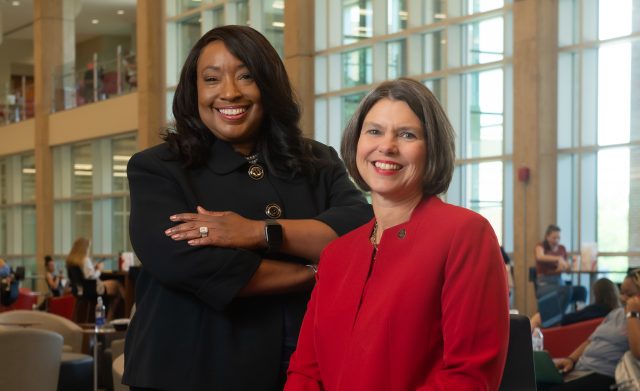
A recent study co-authored by an Ole Miss researcher concluded that the presence of women in top management teams – such as Ethel Young Scurlock (left), dean of the UM Sally McDonnnell Barksdale Honors College, and Donna West Strum, dean of the School of Pharmacy – can have a positive impact on an organization’s customer orientation and financial performance. Photo by Kevin Bain/Ole Miss Digital Imaging Services
OXFORD, Miss. – A new study co-authored by a University of Mississippi marketing professor shows that women in executive corporate leadership positions have a positive impact on customer orientation, which can lead to financial gains.
“Women bring unique strengths to top management teams,” said Saim Kashmiri, associate professor of marketing and co-author of the research. “However, as we all know, there is a gender disparity, especially in senior-level positions. Only 30 S&P 500 CEOs are women, which is roughly 6%.
“We wanted to explore this and see if gender balance makes a difference in marketing choices and performance advantages.”
In short, it does. Kashmiri and his team analyzed 389 Fortune 500 companies over eight years and found that female leaders were more likely to prioritize customer relationships and encourage customer-oriented discussions in the C-suite.
This emphasis on the customer resulted in a positive effect on the company’s long-term financial performance.
The researchers accomplished this by developing a metric that considers not only the frequency of women leaders, but also influence of power.
“If you have women leaders, but give them no power or important job titles, they can’t make a meaningful contribution,” Kashmiri said. “So, we measured what we call female influence in the top management team, or FITMT.”
Kashmiri suspected a link between female executives and customer orientation. Prior psychology literature has shown that women are more interdependent and relational in how they view themselves.
“If this is true, and this phenomenon occurs at the individual level, the kinds of choices that women will make in leadership roles will be different from their male counterparts,” Kashmiri said. “Our research shows that women will value relationships with stakeholders more.
“One of the key external stakeholders is the customer; if female executives encourage firms to have a greater emphasis on satisfying customer needs, this is likely to result in superior financial performance.”
Chandra Srivastava, assistant professor of marketing at St. Edwards University, co-authored the study.
“The societal push for putting women in higher levels of leadership can be met with resistance,” Srivastava said. “Some investors and managers worry that female candidates aren’t as qualified and have less to bring to the table than the male candidates they are up against.
“We now have evidence that women not only bring additional skills and perspectives to the table, but their inclusion in the C-suite also has positive financial implications for many firms.”
The study combats the narrative that women executives are primarily driven by risk-avoidance, Srivastava said. When the researchers found that customer orientation is an important driver of female executives’ decision-making, they also discovered that women may be willing to take more risks than males if the decision will serve customers.
“I’m hoping that this study, and other emerging ones like it, start to shift the narrative away from focusing on concerns about what could happen with greater gender balance in the C-suite to what is possible,” Srivastava said. “In actuality, there are many upsides.”
While solely appointing male leaders is problematic for a company, an all-female management team would present its own issues, Kashmiri said. Therefore, firms should strive for a healthy mix of male and female executives.
The paper was recently published online by the Journal of Marketing. The journal has a rigorous review process and accepts only manuscripts with “topical interest,” said Barry Babin, chair of the Ole Miss marketing department.
“Any publication in the Journal of Marketing is an admirable achievement,” he said. “Only a very small percentage of marketing scholars will ever do so.
“Any time our faculty are able to publish in one of the top journals in the field, the university gains status among scholars in the marketing discipline. No journal has a wider readership in the field of marketing than JM.”
